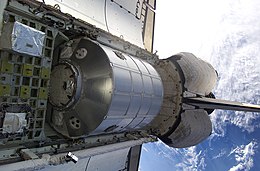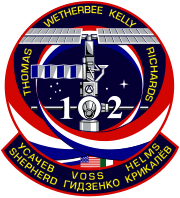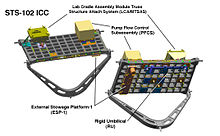STS-102
 ICC (left) and the MPLM Leonardo (center) in Discovery's payload bay | |
| Names | Space Transportation System-102 |
|---|---|
| Mission type | ISS crew transport and resupply |
| Operator | NASA |
| COSPAR ID | 2001-010A |
| SATCAT no. | 26718 |
| Mission duration | 12 days, 19 hours, 49 minutes, 32 seconds |
| Distance travelled | 8,621,951 km (5,357,432 mi) |
| Orbits completed | 102 |
| Spacecraft properties | |
| Spacecraft | Space Shuttle Discovery |
| Launch mass | 99,503 kg (219,367 lb) |
| Landing mass | 90,043 kg (198,511 lb) |
| Payload mass | 5,760 kg (12,700 lb) |
| Crew | |
| Crew size | 7 |
| Members | |
| Launching | |
| Landing | |
| EVAs | 2 |
| EVA duration |
|
| Start of mission | |
| Launch date | 8 March 2001, 11:42:09 UTC (6:42:09 am EST) |
| Launch site | Kennedy, LC-39B |
| End of mission | |
| Landing date | 21 March 2001, 07:31:41 UTC (2:31:41 am EST) |
| Landing site | Kennedy, SLF Runway 15 |
| Orbital parameters | |
| Reference system | Geocentric orbit |
| Regime | Low Earth orbit |
| Perigee altitude | 370 km (230 mi) |
| Apogee altitude | 381 km (237 mi) |
| Inclination | 51.5° |
| Period | 92.1 minutes |
| Docking with ISS | |
| Docking port | Destiny forward |
| Docking date | 10 March 2001, 06:38 UTC |
| Undocking date | 19 March 2001, 04:32 UTC |
| Time docked | 8 days, 21 hours, 54 minutes |
 Mission patch  Top group, from left: Kelly, Thomas, Wetherbee and Richards Bottom left is the landing Expedition 1 crew, from left: Krikalev, Shepherd and Gidzenko Bottom right is the launching Expedition 2 crew, from left: Voss, Usachov and Helms | |
STS-102 was a Space Shuttle mission to the International Space Station (ISS) flown by Space Shuttle Discovery and launched from Kennedy Space Center, Florida. STS-102 flew in March 2001; its primary objectives were resupplying the ISS and rotating the Expedition 1 and Expedition 2 crews. It was Discovery's 29th flight. The first EVA performed on the mission remains the longest spacewalk ever undertaken at eight hours and 56 minutes.
Crew
| Position | Launching crew | Landing crew |
|---|---|---|
| Commander | Fifth spaceflight | |
| Pilot | First spaceflight | |
| Mission Specialist 1 | Third spaceflight | |
| Mission Specialist 2 Flight Engineer |
Only spaceflight | |
| Mission Specialist 3 | Expedition 2 Fourth and last spaceflight |
Expedition 1 Fourth and last spaceflight |
| Mission Specialist 4 | Expedition 2 Fifth and last spaceflight |
Expedition 1 Second spaceflight |
| Mission Specialist 5 | Expedition 2 Fifth and last spaceflight |
Expedition 1 Fifth spaceflight |
Crew seat assignments
| Seat[1] | Launch | Landing |  Seats 1–4 are on the flight deck. Seats 5–8 are on the mid-deck. Seat 8 was located to the starboard (right) side of Seat 7.[1] |
|---|---|---|---|
| 1 | Wetherbee | ||
| 2 | Kelly | ||
| 3 | Thomas | Unused | |
| 4 | Richards | ||
| 5 | Voss | Thomas | |
| 6 | Helms | Krikalyov | |
| 7 | Usachov | Gidzenko | |
| 8 | Unused | Shepherd | |
Unique to this flight, Shepherd, Gidzenko, and Krikalev were all seated together on the mid-deck in special "recumbent couches" that allowed them to stay in a laid-back reclining position during landing, instead of the usual upright seats. It was thought that after their four months in space, their bodies would be deconditioned and the recumbent position would minimize the impacts of returning to a gravity environment.[2] Because of the special seats, Thomas moved to the normal number 5 seat on the mid-deck to operate the side hatch as necessary. Future shuttle missions would not use the recumbent couches.
Spacewalks

- EVA 1
- Personnel: Voss and Helms
- Start: 11 March 2001, 05:12 UTC
- End: 11 March 2001, 14:08 UTC
- Duration: 8 hours, 56 minutes
- EVA 2
- Personnel: Thomas and Richards
- Start:13 March 2001, 05:23 UTC
- End: 13 March 2001, 11:44 UTC
- Duration: 6 hours, 21 minutes
Mission highlights
Space Station Assembly Flight ISS-5A.1 was the first use of the Multi Purpose Logistics Module (Leonardo) to bring supplies to the station. The steel modules were equipped with up to 16 International Standard Payload Racks for installation in the US Lab. Also carried an Integrated Cargo Carrier (ICC). The ICC had the External Stowage Platform-1 mounted on its underside. ESP-1 was placed on the port side of 'Destiny' as a storage location for ORUs. The mission also included two spacewalks to relocate the units carried up by the ICC to the Destiny module exterior.
Wake-up calls
NASA began a tradition of playing music to astronauts during the Gemini program, which was first used to wake up a flight crew during Apollo 15.[3] Each track is specially chosen, often by their families, and usually has a special meaning to an individual member of the crew, or is applicable to their daily activities.[3][4]
| Flight Day | Song | Artist/Composer |
|---|---|---|
| Day 2 | "Living the Life" | Rockit Scientists |
| Day 4 | "Nothing's Gonna Stop Us Now" | Starship |
| Day 6 | "From A Distance" | Nancy Griffith |
| Day 7 | "Free Fallin'" | Tom Petty & the Heartbreakers |
| Day 8 | "Should I Stay or Should I Go" | The Clash |
| Day 12 | "Moscow Windows" | Unknown |
See also
- List of human spaceflights
- List of International Space Station spacewalks
- List of Space Shuttle missions
- List of spacewalks and moonwalks 1965–1999
- Outline of space science
References
![]() This article incorporates public domain material from websites or documents of the National Aeronautics and Space Administration.
This article incorporates public domain material from websites or documents of the National Aeronautics and Space Administration.
- ^ a b "STS-102". Spacefacts. Retrieved 1 September 2024.
- ^ "Space Station 20th: STS-102 Performs First International Space Station Crew Rotation, Returns Expedition 1 to Earth – NASA". 24 March 2021. Retrieved 2 September 2024.
- ^ a b Fries, Colin (25 June 2007). "Chronology of Wakeup Calls" (PDF). NASA. Archived from the original (PDF) on 5 June 2010. Retrieved 13 August 2007.
- ^ NASA (11 May 2009). "STS-102 Wakeup Calls". NASA. Archived from the original on 13 April 2001. Retrieved 31 July 2009.
External links
- NASA mission summary Archived 10 June 2016 at the Wayback Machine
- STS-102 Video Highlights Archived 4 December 2013 at the Wayback Machine


